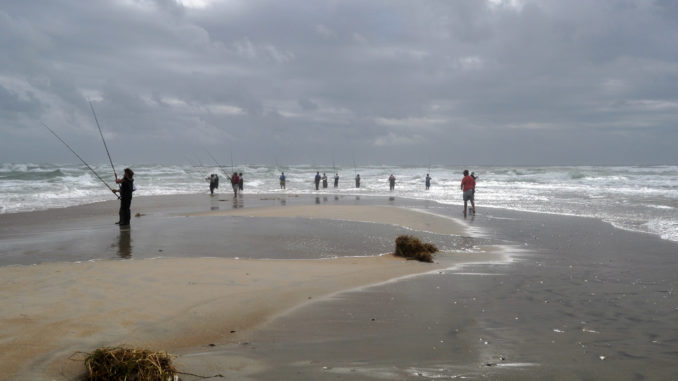
NPS allowed to issue critical-habitat designation
Outer Banks residents and visiting anglers who visit the Cape Hatteras National Seashore believe that flawed science is behind the federal government’s attempts to shut down public beach access.
Ironically, actions taken by the federal courts and the U.S. Fish and Wildlife Service are apparently creating more problems for threatened birds, according to one long-time Outer Banks resident who is also a surf fisherman and bird watcher.
In July, District Chief Judge Royce Lamberth ruled in Washington, D.C., that the USFWS didn’t impose unnecessary restrictions or infringe on the rights of Outer Banks business owners and residents when it established “critical habitat” designation for wintering piping plovers, which area listed as “threatened” by the Endangered Species Act.
Critical- habitat designation means federal land that is home to or may become home to threatened or endangered species can’t be altered or affected in any way that would threaten the survival of those species. The bottom line is that critical-habitat designation affords another legal precedent for permanently closing sections of the OBX to human activity.
The decision was met with dismay by pro-access OBX supporters because it could lead to winter beach closures during prime fishing months and negatively affect local businesses, already hurt by a 2008 beach-access consent decree arranged by a federal judge.
Oddly enough, few piping plovers winter on North Carolina beaches, according to several experts, including Larry Hardham, the president of the Cape Hatteras Anglers Club, who also is an avid bird watcher.
“What it means is the (NPS) will feel justified in maintaining winter closures at the interiors of Cape Point and several ‘spits,’” Hardham said. “The end result of that will be the destruction of breeding habitat. It’s an extreme condition toward an ultimate goal, because that already has happened at Oregon Inlet and is happening at Cape Point.”
“Spits” include areas on both sides of Oregon Inlet, Hatteras Inlet and Ocracoke Inlet, all popular surf-fishing areas, while Cape Point is the most famous surf-fishing venue on the east coast.
Hardham pointed out only four breeding activities of plovers have been documented at Bodie Island spit (the north side of Oregon Inlet) during the last 10 years.
“In 2009, there were no breeding pairs of plovers at the spit, and in 2008 there was one nest and one pair of birds that produced no chicks. In 2007, one chick fledged,” he said.
Before land around the spit was declared off limits, plovers nested there because they prefer open sandy areas not covered by vegetation. Human activities around a man-made pond now closed to any visitation created the open areas.
Hardham said when the feds impose critical habitat on any area, the precise conditions that allow plovers to thrive all but disappear.
“What happens is because recreational use is denied, these areas grow up in vegetation,” Hardham said. “The interior of the north side of Oregon Inlet used to be open for recreational use and was a successful plover breeding ground. Now, since it’s been closed off year-round, vegetation has taken over, and no piping plovers have successfully bred there for four or five years.”
As a result, Hardham said critical habitat designation lowers bird numbers.
“The whole closure concept deals with human intervention affecting breeding activity,” he said. “But (human intervention) is well below in its impacts compared to predation and weather events.”
Hardham said recreational use of the shoreline is actually “the low man on the totem pole (affecting plovers), yet they deal with that like it’s a major cause.”
Pro-access groups — such as the Cape Hatteras Preservation Alliance (CHAPA), comprised of clubs such as the Cape Hatteras Anglers Club, the Outer Banks Preservation Association and N.C. Beach Buggy Association — have been some of the best stewards of habitat and wildlife at the Seashore. CHAPA fought in federal courts and won a decision against the U.S. Fish and Wildlife Service in 2004 when the court remanded critical-habitat designation attempts back to the FWS in order to correct errors in its defense. Chief among those was CHAPA’s charge that FWS hadn’t used good science.
“One reason CHAPA won in 2004 was that judge said FWS hadn’t done a comprehensive economic-impact study,” Hardham said. “Well, (FWS) went right back and did a rehash of the same economic study, but this time the judge approved the critical-habitat designation.”
Hardham said a peer review by the NPS of the first economic impact analysis study said, “it wasn’t of good-enough quality” to be used as an effective tool.
“A firm in Massachusetts was contacted to do the second study, but they didn’t come and didn’t talk to the first person, outside the NPS,” he said. “But they still used (the previous) results. Does that make any sense? Also, in their study, they considered the entire 24,660 acres of the seashore as potential beach-driving areas instead of the less than 1,000 acres that actually can be used.
“I think the American public deserves better than that, to use junk science to make such an important decision.” U



